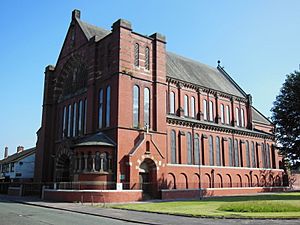Corpus Christi Priory facts for kids
The Corpus Christi Priory was once a Catholic priory located in Manchester, England. A priory is like a monastery, a place where a group of religious people, called canons, live and pray together. This priory belonged to a special group of canons known as the Premonstratensians.
About the Church Building
The Premonstratensian canons, also known as Norbertines, first arrived in Manchester in 1889. They came from a place called the Abbey of Tongerlo in Belgium. Their goal was to build a new church, which they named Corpus Christi Basilica. A basilica is a large and important church building.
The church was built in an area of Manchester called Miles Platting. William Telford Gunson was the person who designed this beautiful building. The first stone, called the foundation stone, was placed on July 14, 1906, by Bishop Louis Charles Casartelli. The church officially opened its doors to the public the next year, on November 5, 1907. Later, the Corpus Christi Basilica was recognized as a Grade II listed building. This means it is an important historical building that needs to be protected.
Why the Priory Closed
In 2004, Corpus Christi became an independent "canonry." This means it became a self-governing community within the Premonstratensian order. The Norbertine canons continued to live and serve there for a few more years. However, by 2007, the church building needed a lot of expensive repairs and maintenance. Because of these high costs, the priory had to close.
The very last church service, called Mass, was held on April 27, 2007. After the closure, the community of canons moved to a different church, St Chad's, in Cheetham Hill. Then, in 2008, they moved again to Our Lady Immaculate Church in Chelmsford, Essex.
See also
 In Spanish: Priorato de Corpus Christi para niños
In Spanish: Priorato de Corpus Christi para niños


